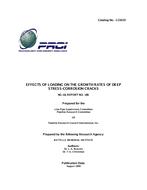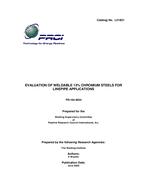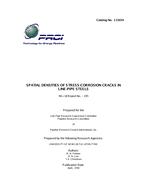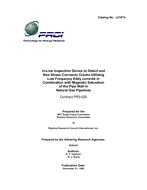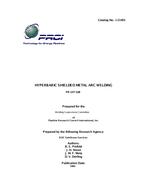Provide PDF Format
PRCI Report 186
- Effects of Loading on the Growth Rates of Deep Stress-Corrosion Cracks
- Report / Survey by Pipeline Research Council International, 08/01/1990
- Publisher: PRCI
$125.00$249.00
L51619e
Battelle Memorial Institute
(Need: With the development of improved techniques for detection of stress corrosion cracks in existing pipelines, the pipeline industry is faced with the problem of estimating the growth rates of these cracks. Current efforts in model development are addressing the problem but, in order to verify these models, accurate average crack velocity data are needed (average crack velocity being defined as the average rate of crack growth with time, crack velocity is the instantaneous rate of crack tip dissolution.) Currently available data are limited and are based primarily on either slow-strain rate tests or tapered tensile tests. The loading conditions in the former are unrepresentative of actual operating conditions while the crack depths in the latter are much shallower than those observed in service. Some fracture mechanics data also are available for this system but the specimen and crack geometry used in these tests are not similar to the geometry of the field failures*. In addition, results of recent PRCI research suggest that the stress intensity parameter, K, which is used to relate different cracking geometries, is a poor crack driving force parameter for SCC in line pipe steels.
Benefit: The overall objective of this work is to obtain accurate average crack velocity data as a function of crack depth and loading conditions. The program is divided into two tasks: Task 1 - Effect of Crack Depth and Cyclic Loading Conditions on Crack Growth and Task 2 - Inhibition of Crack Growth.
Result: The most significant finding of this research was that stress-corrosion cracks nucleated by the high-stress slow-strain technique showed only limited growth during subsequent cycling at lower stresses. This indicates that this technique is not suitable for measuring average crack growth rates. Probably the residual compressive stresses left at the crack tip by the original slow-strain phase inhibited growth in the cyclic phase.
Battelle Memorial Institute
(Need: With the development of improved techniques for detection of stress corrosion cracks in existing pipelines, the pipeline industry is faced with the problem of estimating the growth rates of these cracks. Current efforts in model development are addressing the problem but, in order to verify these models, accurate average crack velocity data are needed (average crack velocity being defined as the average rate of crack growth with time, crack velocity is the instantaneous rate of crack tip dissolution.) Currently available data are limited and are based primarily on either slow-strain rate tests or tapered tensile tests. The loading conditions in the former are unrepresentative of actual operating conditions while the crack depths in the latter are much shallower than those observed in service. Some fracture mechanics data also are available for this system but the specimen and crack geometry used in these tests are not similar to the geometry of the field failures*. In addition, results of recent PRCI research suggest that the stress intensity parameter, K, which is used to relate different cracking geometries, is a poor crack driving force parameter for SCC in line pipe steels.
Benefit: The overall objective of this work is to obtain accurate average crack velocity data as a function of crack depth and loading conditions. The program is divided into two tasks: Task 1 - Effect of Crack Depth and Cyclic Loading Conditions on Crack Growth and Task 2 - Inhibition of Crack Growth.
Result: The most significant finding of this research was that stress-corrosion cracks nucleated by the high-stress slow-strain technique showed only limited growth during subsequent cycling at lower stresses. This indicates that this technique is not suitable for measuring average crack growth rates. Probably the residual compressive stresses left at the crack tip by the original slow-strain phase inhibited growth in the cyclic phase.
Related Products
PRCI PR-164-9634
Evaluation of Weldable 13% Chromium Steels for Linepipe Applications..
$298.00 $595.00
PRCI PR-3-025
In-Line Inspection Device to Detect and Size Stress Corrosion Cracks Utilizing Low Frequency Eddy Cu..
$148.00 $295.00

